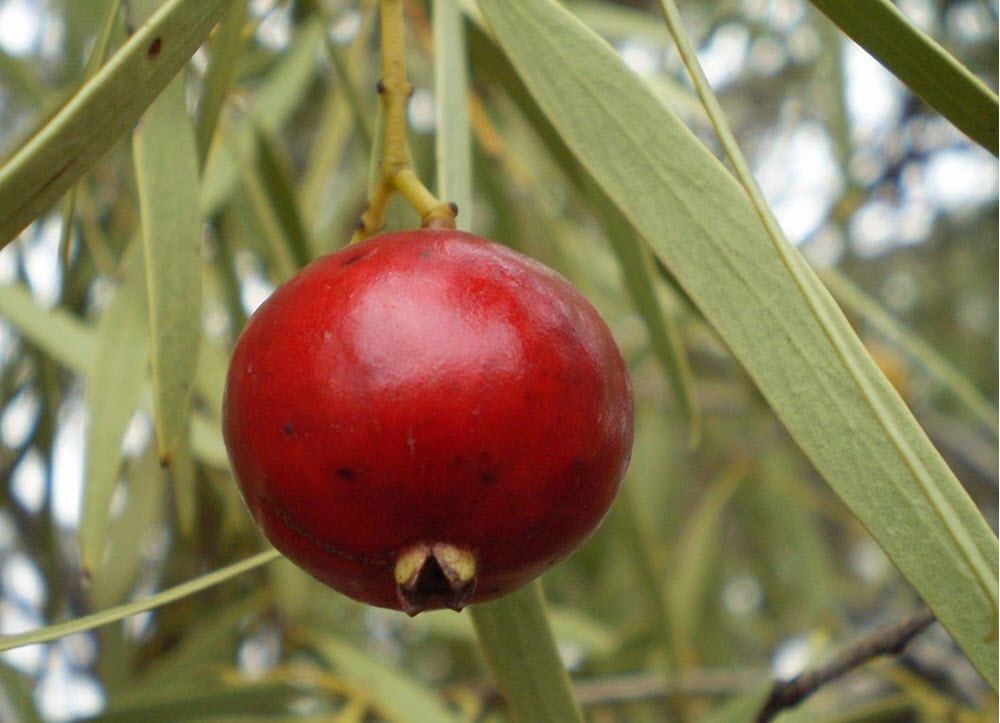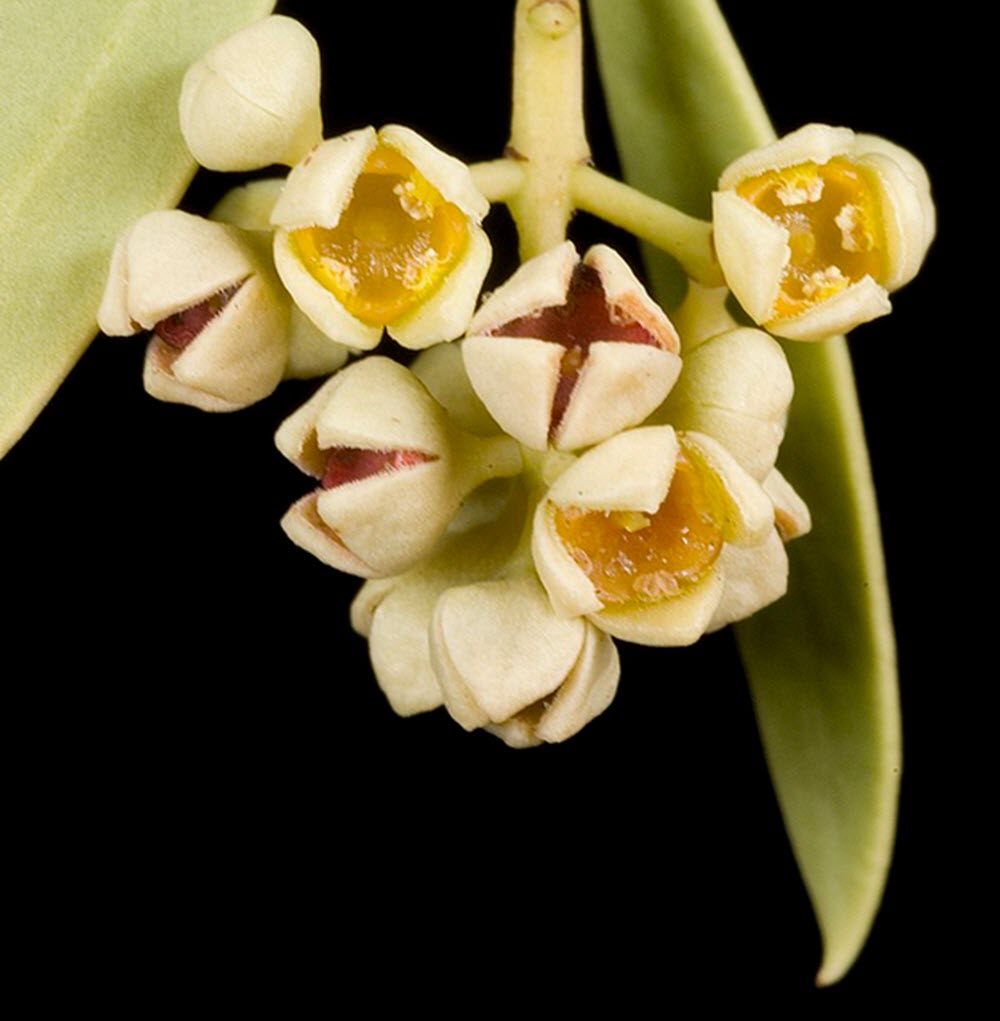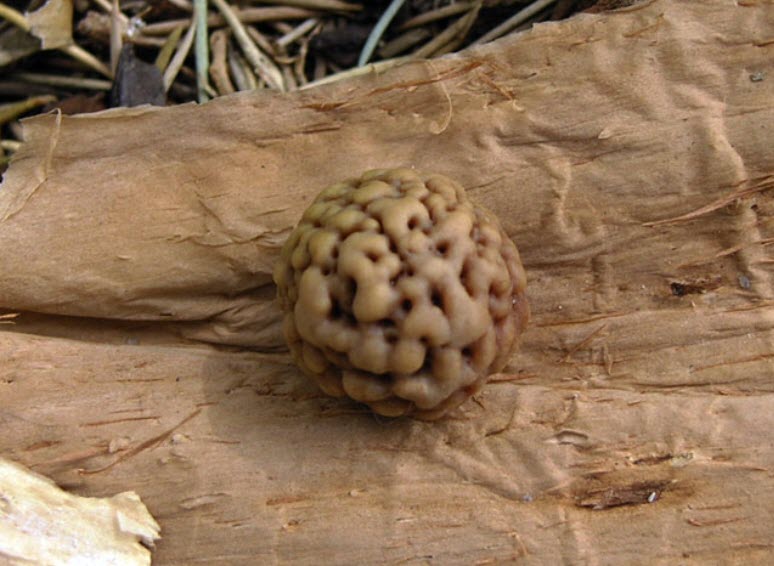Desert Quandong (Santalum acuminatum)
The desert quandong (Santalum acuminatum) is a fascinating species of plant that indigenous Australians have used for millennia. Also known as the sweet quandong or native peach, this tree has an impressive ability to survive and thrive in the harsh Australian outback.

Understanding the Botany of Santalum acuminatum
The desert quandong is a hemiparasitic plant that belongs to the Santalaceae family; a family comprising about 25 species of mostly Australian native plants.
The desert quandong grows as a small tree or tall shrub, and typically attains a height of 3-6 metres and a with of 2-4 metres.
It is not unusual to see a larger plant surrounded by smaller plants, which were formed by suckers emerging from the roots of the larger plant.
It is a hemiparasite
Its life as a hemiparasite means that, while the quandong tree is capable of synthesizing a portion of its nourishment, it also draws non-sugary nutrients, and water, from the roots of neighboring plants using specialized structures called haustoria. These haustoria can reach out by as much as 10 metres to reach the root system of another plant. Studies show that this type of hemiparasite can obtain around 70% of its nitrogen needs, and some of its water requirements, from the roots of other plants.
The haustoria have pad-like structures that will almost encircle the host´s root. When possible, the desert quandong will use more than one plant as host. Not just other trees and bushes are utilized; it attaches to grasses as well.
The desert quandong also benefit from other plants as they provide shade. Typically, the seedling will establish itself in the shade of a host plant and not reach full sun until it is much more developed and capable of handling and benefiting from strong sunlight.
Bark
The bark of the desert quandong is dark grey.
Leaves
The desert quandong develops shiny, light to dark green leaves which contrast strikingly against the vibrantly red fruits. The leaves are slender, ovate and pointed at the tip. They have a leathery appearance.
Each leaf is 45-115 mm long. The leaf stems are just 5-10 mm long.
It is not uncommon for the foliage of this species to be much paler than that of surrounding plants of other species, which makes such desert quandongs stand out in bushlands and scrublands.
Flowers
The flowers are greenish to creamy white on the outer parts, with the inner faces showing reddish and yellowish-brown colours. The flowers are small, just 2-3 mm across, and grow on stems.
The flowers are fragrant.

Fruits and nuts
These fruits, which are red to yellowish, and roughly 20-40 mm across, feature a thin layer of edible flesh, encasing a hard, wrinkled nut inside. The seed is protected by the hard nut shell.
Fruit is produced by specimens aged 4 years or more. The fruit will ripen from green to red in late spring or summer. The skin is waxy.

Geographical Distribution
The desert quandong thrives in the dry climates and sandy soils of the Australian outback. It is widely distributed across central and southern Australia, from Western Australia’s mid-west region extending towards the east coast and as far down south as the Eyre Peninsula in South Australia.
In Western Australia, wild desert quandong grow as far north as Carnavaron and Karratha.
Desert quandong exists in several other parts of Australia too, but not as commonly.
The range of the desert quandong was larger in the past, but it has been negatively impacted by wilderness being turned into farmland, especially for the growing of wheat. In some parts of Australia, remote isolated groups remain as a testament to the former, more extensive, distribution range. Such a group can be separated from other desert quandong groups by hundreds of kilometres.
Habitat
This species exhibits immense adaptability, flourishing not just in the harsh, dry climates and sandy soils of the Australian outback, but also in coastal dunes, creeki beds, granite areas, gravel plains, mallee scrub, and semi-arid woodlands. The vitality and resilience of the desert quandong is truly impressive.
The species is tolerant of drought, salt and high temperatures. Many parts of its native range are prone to bushfires. Typically, the part of the plant that is above ground will die, but the roots will survive the fire, and the plant will regenerate from them. In environments with frequent bushfires, it is unusual for the species to ever become a fully grown tree. The same is true for plants growing in areas subjected to frequent soil disturbances; they grow as sprawling shrubs with many stems instead of becoming trees or even tall bushes.
Regrowing from the root system means that the desert quandong can reemerge quickly after a fire, when many other plant species have to go through the process of growing from seeds and establishing a new root system.
Desert quandongs that grow to be trees are normally found in places where they aren’t damanged by fires or soil disturbances. If they are allowed to grow old, they can overwhelm nearby plants by making the spot too shady for them, and by extracting too much water and nutrients from the roots.
Ecological Impact
The desert quandong plays a vital role in its unique ecosystem. Its fruits serve as a rich food source for various animals, including emus and kangaroos. When the animals defecate the seeds after consumption, the quandong gains a means of propagating itself over large distances.
Several insects feed on the desert quandong, including the quandong moth (Paraepermenia santaliella) and the larva of the red-spotted Jezebel butterfly (Delias aganippe).
Human Uses of the Desert Quandong
Indigenous use as food and medicine
The desert quandong has been a staple of the Australian Aboriginal diet for thousands of years. Indigenous Australians used the plant for both nutritional and medicinal purposes. For instance, the fruit is often eaten fresh, but can also be dried and preserved for later use. The kernels are ground into a paste to create a type of bush bread, while the leaves are boiled to make a medicinal tea.
The plant has many different names, since it has a long history with peoples speaking languages belonging to various indigenous language groups. Here are a few examples:
- The Wiradjur people of New South Wales use the name guwandhang, and this is believed to be the origin of the English adapted name quandon.
- The Noongar of South Western Australia use the name wolgol.
- The Wotjobaluk of Western Victoria use the name gutchu.
- The Narungga use the name goorti.
- The Pitjantjatjara use the names wanjanu and magata.
Fuel and fire-starter
The desert quandong seed is high in flammable oils which can be burnt to provide light.
The wood is also oily, and a good choice if you need to use a friction stick to start a fire.
Timber
The timber is hard, durable and oily. Among regional carpenters, it is sometimes used for cabinet making, but it does not have the aromatic properties of the more commonly used sandalwoods (genus Santalum).
Miscellaneous
The nuts, which are hard and wrinkled, are used as shirt buttons and to serve as marbles when playing chinese checkers. They are also worn decoratively, e.g. on necklaces.
Modern Culinary and Cosmetic Applications
The desert quandong fruits is now gaining popularity in high-end Australian kitchens where they’re served up in tantalizing dishes, like quandong pie or quandong jam. They bring a unique tanginess to any dish and are often used in place of non-Australian fruits.
And let’s not forget about the booming skincare industry. Australian companies are beginning to incorporate quandong extract into various cosmetic products, thanks to its high content of vitamin C and phenolic acid – both significant antioxidants beneficial for skin health.
Botanical History
The species was first scientifically described by Robert Brown in 1810, in the Prodromus Florae Novae Hollandiae, and was given the scientific name Fusanus acuminatus. The description was made based on specimens from Fowlers Bay, South Australia, collected in 1802. The “acuminatus” part of the name references the leaves, which are sharpened or pointed.
The species got its current scientific name from Alphonse Pyrame de Candolle in 1857, when the species was moved to the genus Santalum (sandalwoods).
Final Thoughts
The desert quandong is a testament to the richness of Australia’s biodiversity, a symbol of cultural heritage, a source of sustainable food and medicinal resources, and a vital link in the ecological web. As more people become aware of the desert quandong’s benefits and uses, there is hope that this extraordinary species will continue to thrive and contribute significantly to Australia’s rich ecological, cultural, and economic tapestry.
